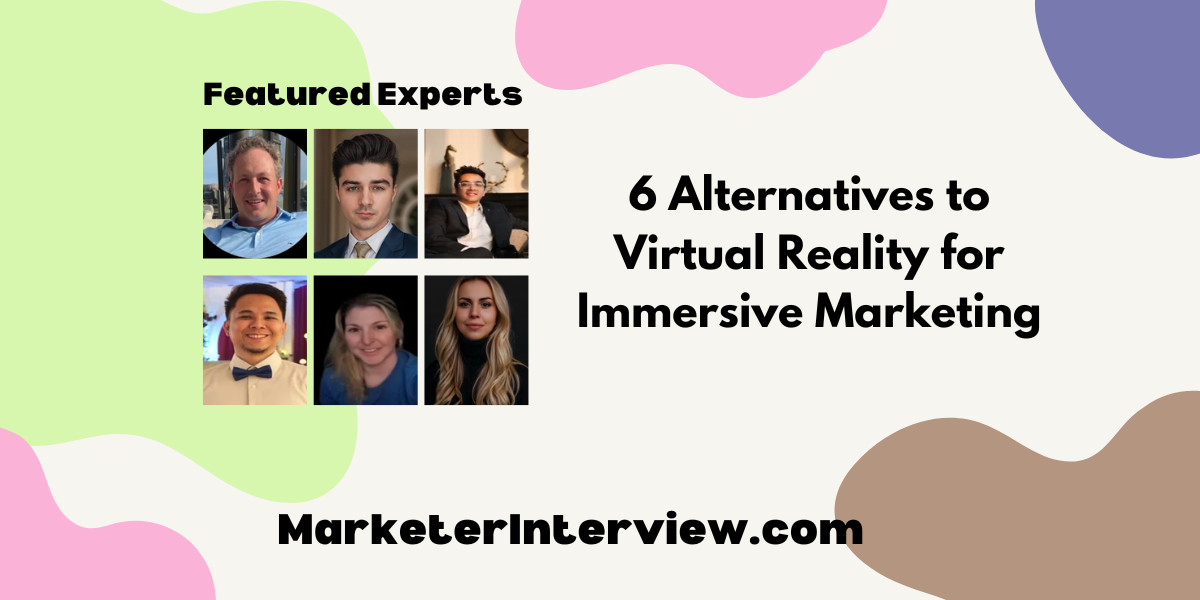6 Alternatives to Virtual Reality for Immersive Marketing
In the search for cutting-edge alternatives to virtual reality for immersive marketing, we’ve gathered insights from six industry experts, including marketing directors and founders. They delve into options ranging from embracing mixed reality for full immersion to how augmented reality can make immersive experiences more accessible. Discover the diverse strategies recommended for engaging your audience beyond the virtual realm.
Want to get quoted in MarketerInterview.com content just like this? Apply to become a contributor today!
Contents
Embrace Mixed Reality for Immersion
If you’re searching for an alternative to virtual reality that still offers a deep dive into immersive marketing, then mixed reality (MR) might just be what you need. Mixed reality blends the best bits of both virtual reality (VR) and augmented reality (AR), creating a hybrid that’s engaging without the need for pricey gear.
Mixed reality lets you interact with digital elements overlaid on your real-world environment, much like AR. But it also pulls in some immersive aspects of VR, making the experience even more engaging and realistic. You get to enjoy the depth of VR with the accessibility of AR—it’s like having your cake and eating it too.
A prime example of mixed reality in action is Time Magazine’s Time Immersive app. This interactive app combines AR and VR to deliver news stories and historical events in a captivating and innovative way, offering users a fun, visually appealing new method to engage with content.

Patrick Beltran, Marketing Director, Ardoz Digital
Transform Spaces With Projection
What about using the facade of a city building as a canvas to create something truly special for your customers? That’s where projection comes in as a fantastic alternative to virtual reality for immersive marketing.
Although projection isn’t a brand-new technology, it’s increasingly being used to enhance immersive experiences. When you add audio to the mix, the impact becomes even more compelling and unique for the audience.
Using projections, you can transform an ordinary building into a spectacular display that captures attention and immerses viewers in a sensory experience that’s both visual and auditory. This method not only draws in passersby but also leaves a memorable impression, making it an excellent choice for marketers looking to make a big impact with their campaigns.

Lydia Valentine, Co-Founder and Chief Marketing Officer, Cohort XIII LLC
Engage With 360-Degree Video
A particular substitute for virtual reality in immersive marketing can be 360-degree video. It allows users to look around them in a video as if they’re physically there. It is not necessary to have specific goggles or equipment to view it on a computer or phone. More individuals will find it easy to enjoy immersive entertainment without having to buy pricey equipment, thanks to this.
Furthermore, compared to virtual reality, which requires more sophisticated installations and software, it is easier to develop and share. Therefore, without the limitations of VR technology, 360-degree video provides a more approachable means of engrossing consumers in a brand’s narrative or experience.

Kartik Ahuja, Digital Marketer, kartikahuja.com
Augmented Reality Enhances Customer Choices
Augmented reality would be my choice for immersive marketing that provides an alternative to virtual reality. At Dancing Chicken Media, we created an AR app for Exquisite Auto Detailing that allowed customers to view virtual representations of detailing jobs on their own vehicles. The app let users see what their car would look like with different packages so they could choose the service that best fit their needs and budget.
After launching the AR app, Exquisite Auto Detailing saw a substantial increase in sales and customer retention. The AR experience forged an emotional connection between the brand and consumers that translated to real business impact. For companies looking to enhance the customer journey in a personal yet scalable way, AR is an innovative tool that delivers results.
We also utilized AR for Wood Quality Home Remodeling to allow customers to envision how new cabinets, flooring, or countertops would appear in their own kitchens or bathrooms. The AR app reduced choice paralysis, streamlined the selection process, and boosted close rates for kitchen and bath remodeling services. AR brings immersive experiences to life in a way that resonates with consumers and motivates them to take action.

Mason Boroff, Founder & Head of Advertising, Dancing Chicken Media
Create Impact With Experiential Marketing
Experiential marketing stands out as a compelling alternative to virtual reality for immersive marketing. Unlike digital simulations, it creates real-life, interactive experiences that engage all the senses. At a recent aviation expo, for example, we installed a flight-simulator booth where attendees could experience the excitement of flying firsthand. This approach not only captured their interest but also left a lasting impression through physical interaction with our product.
Experiential marketing utilizes physical spaces and live interactions to immerse participants in a brand’s story or product benefits, fostering deeper connections and memorable experiences. This hands-on approach proves effective in industries where tactile experience influences consumer decisions, offering a unique mix of engagement and authenticity that virtual reality alone may not achieve.

Michael Leek, Founder, Simuvation
Augmented Reality for Accessible Immersion
Augmented reality (AR) offers a compelling alternative to virtual reality for immersive marketing. Unlike VR, which creates entirely virtual environments, AR overlays digital elements onto the real world, enhancing the user’s existing surroundings. This approach allows customers to interact with products in a real-world context, such as visualizing how furniture fits in their home or trying on virtual clothing through their smartphone.
One notable example is IKEA’s AR app, which lets users see how different furniture pieces would look in their space before making a purchase. AR provides an interactive and engaging experience without the need for specialized VR equipment, making it more accessible and immediately impactful for both brands and consumers.

Jordan DeGusipe, Licensed PA Realtor, RE/MAX Professionals
Want to get quoted in MarketerInterview.com content just like this? Apply to become a contributor today!






